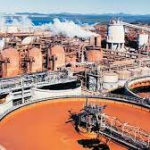 The global alumina market is set to be in a state of uncertainty in the second quarter of this year, as fallout from the war between Russia and Ukraine and a confluence of interconnected factors could alter supply and demand fundamentals.
The global alumina market is set to be in a state of uncertainty in the second quarter of this year, as fallout from the war between Russia and Ukraine and a confluence of interconnected factors could alter supply and demand fundamentals.
In the first quarter of 2022, Australia’s alumina price rose to levels not seen since US sanctions against Russian aluminium giant Rusal and production cuts at Brazil’s Alunorte refinery in 2018. Western Australia FOB alumina valuations peaked at $533/mt in Q1, surpassing a high of $484/mt in Q4 2021.
The alumina market had expected global prices to fall in the first quarter following the Beijing Winter Olympics, but this was not the case. Chinese domestic prices were the exception as reduced refining capacity in northern China was gradually increased after the games.
Australia’s 20 March ban on alumina and bauxite exports to Russia, however, caused an immediate global surplus. Prices fell within days to close the first quarter at $478/mt FOB, falling below the $400/mt mark on 8 April.
This quarter, market participants are likely to keep an eye on developments regarding Rusal’s international activities and how it will carve out its overseas operations to distance itself from Russia. Increased supply from Australia will also be a focus of attention.
Market participants expect to see more Australian cargoes made available to the wider market. Russia imported 1.52 million tonnes of alumina from Australia in 2021, a third of the 4.7 million tonnes of alumina imported by the country. The total includes 2.65 million tonnes from Rusal’s alumina refineries in Ukraine, Ireland, Guinea and Jamaica.
Australian cargoes that were imported into China before the war and stored in bonded warehouses could be an alternative source of sales to Russia, although it is uncertain whether and how the export ban could be implemented retroactively on these goods, given that they have arrived on Chinese shores before.
Market participants will monitor Rusal’s subsequent alumina supply after Australia’s export ban, amid renewed discussions about Chinese domestic alumina exports filling the supply gap.
China, the world’s largest alumina producer, sold 780 tonnes to Russia in 2021, almost nothing compared to the volumes coming from traditional destinations.
Subsequent Chinese alumina exports will shed light on domestic price movements, as it remains to be seen how demand and new Chinese alumina production capacity will balance out.
Rusal’s stakes in the Aughinish refinery in Ireland and the Queensland Alumina Limited refinery in Australia increase the potential for disruptions in production and trade flows in light of the ongoing geopolitical crisis.
The 1.99 million mt/year QAL refinery suffered its first interruption in bauxite supply since Rio Tinto announced on 10 March that it was severing ties with Russian companies. Market participants reported that bauxite, initially destined for Ukraine, may instead be diverted to Ireland, as Rusal’s Nikolaev refinery in Ukraine stopped production after the invasion.
Further disruptions in alumina supply to Atlantic smelters could push regional aluminium premiums and Brazil’s alumina differential towards the Pacific Basin if Atlantic supply challenges and high loading persist.
At Gladstone, Rusal’s 20% share in the Australian QAL joint venture with Rio Tinto amounts to 742,000 tonnes of alumina from the refinery, out of 3.705 million tonnes for the year. Production amounted to about 94% of capacity utilisation at the 3.950 million tonne per annum plant.
Uncertainty over Rusal’s holdings of its international assets and consequently cross-border alumina trade flows are expected to remain key issues in Q2.
.gif) Loading
Loading

